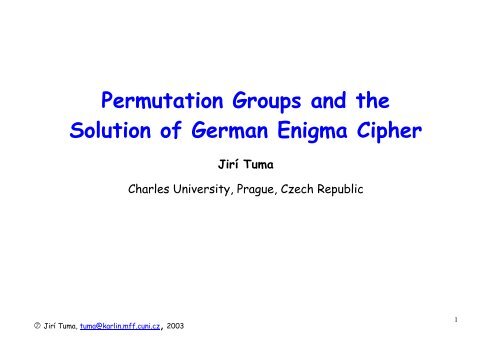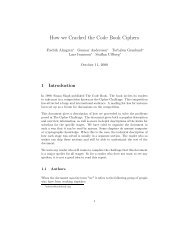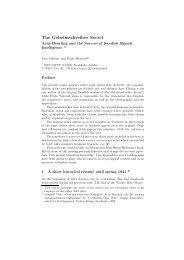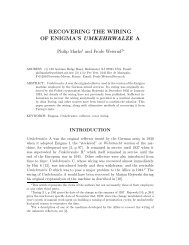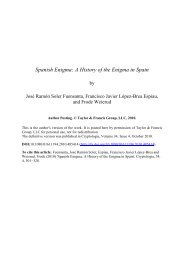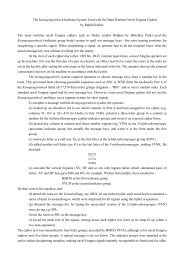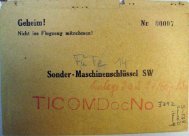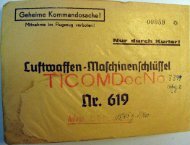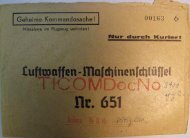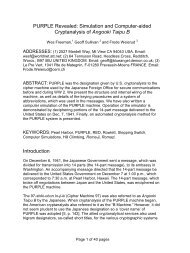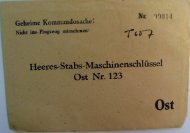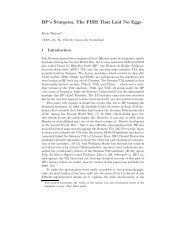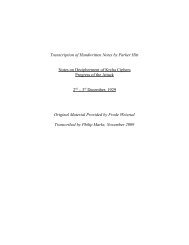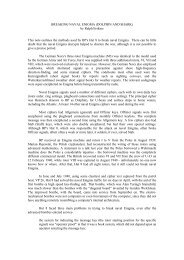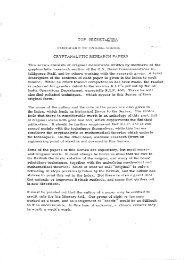Permutation Groups and the - Frode Weierud's CryptoCellar - Cern
Permutation Groups and the - Frode Weierud's CryptoCellar - Cern
Permutation Groups and the - Frode Weierud's CryptoCellar - Cern
Create successful ePaper yourself
Turn your PDF publications into a flip-book with our unique Google optimized e-Paper software.
<strong>Permutation</strong> <strong>Groups</strong> <strong>and</strong> <strong>the</strong><br />
Solution of German Enigma Cipher<br />
7 Jirí Tuma, tuma@karlin.mff.cuni.cz, 2003<br />
Jirí Tuma<br />
Charles University, Prague, Czech Republic<br />
1
How do cipher systems work?<br />
The sender starts with a plain text. Then with <strong>the</strong> help of a key he<br />
produces a cipher text. The cipher text is created from <strong>the</strong> plain text <strong>and</strong><br />
<strong>the</strong> key by an algorithm. This process is called encryption.<br />
The authorized addressee knows <strong>the</strong> encryption algorithm <strong>and</strong> <strong>the</strong> key <strong>and</strong><br />
deciphers <strong>the</strong> plain text from <strong>the</strong> cipher text <strong>and</strong> <strong>the</strong> key. The reverse<br />
process is called decryption.<br />
An adversary may intercept <strong>the</strong> cipher text <strong>and</strong> attempt to recover <strong>the</strong><br />
original plain text from it. This is called solving <strong>the</strong> cipher, informally<br />
codebreaking.<br />
7 Jirí Tuma, tuma@karlin.mff.cuni.cz, 2003<br />
2
Maxims of cryptology<br />
Never use <strong>the</strong> same key to encrypt two different messages;<br />
Never encrypt <strong>the</strong> same message twice with two different keys;<br />
Always assume that <strong>the</strong> adversary knows <strong>the</strong> encryption algorithm;<br />
Never underrate <strong>the</strong> adversary.<br />
7 Jirí Tuma, tuma@karlin.mff.cuni.cz, 2003<br />
3
Indicators<br />
Security of a cipher system depends mainly on key-exchange, <strong>the</strong><br />
way in which <strong>the</strong> sender <strong>and</strong> <strong>the</strong> authorized addressee exchange <strong>the</strong><br />
message key.<br />
They agree in advance on a position in <strong>the</strong> cipher text that will<br />
contain information from which <strong>the</strong> message key can be recovered.<br />
This information is called an indicator. The indicator is most often<br />
placed at <strong>the</strong> beginning of <strong>the</strong> ciphertext. The indicator is usually not<br />
given in plain text but it is also enciphered in some way.<br />
Thus a cipher text usually has <strong>the</strong> form<br />
indicator messagetext<br />
7 Jirí Tuma, tuma@karlin.mff.cuni.cz, 2003<br />
4
Enigma, first contacts<br />
From 1928 <strong>the</strong> German army Wehrmacht started to test a new cipher<br />
system. This caused panic in <strong>the</strong> ranks of <strong>the</strong> Polish Secret Service. After<br />
<strong>the</strong> end of <strong>the</strong> First World War France <strong>and</strong> Great Britain believed that<br />
Germany was no longer a threat to <strong>the</strong>ir security. However, Pol<strong>and</strong> never<br />
shared this opinion.<br />
Attempts to solve <strong>the</strong> new cipher had been completely unsuccessful for<br />
several years. Even parapsychology was involved but in vain. Finally, someone<br />
in <strong>the</strong> Polish Secret Service got <strong>the</strong> idea that ma<strong>the</strong>maticians could be<br />
useful.<br />
A course in cryptanalysis was organized for students of ma<strong>the</strong>matics at <strong>the</strong><br />
University of Poznan.<br />
7 Jirí Tuma, tuma@karlin.mff.cuni.cz, 2003<br />
5
Young Polish ma<strong>the</strong>maticians<br />
Three of <strong>the</strong> best graduates of <strong>the</strong> course,<br />
Marian Rejewski (1905-1980),<br />
Henryk Zygalski (1906-1978) <strong>and</strong><br />
Jerzy Rózycki (1907-1942)<br />
<strong>the</strong>n accepted <strong>the</strong> offer to work on cryptoanalysis of <strong>the</strong> new cipher.<br />
7 Jirí Tuma, tuma@karlin.mff.cuni.cz, 2003<br />
6
First results<br />
Various statistical tests were applied to <strong>the</strong> intercepted cipher texts. As a<br />
result it became clear that <strong>the</strong> first six letters of each cipher text<br />
formed <strong>the</strong> indicator.<br />
The statistical tests also suggested that <strong>the</strong> cipher is very probably a<br />
polyalphabetic cipher. This means that every letter of <strong>the</strong> plain text is<br />
replaced by a single corresponding letter in <strong>the</strong> cipher text. The cipher<br />
letter depends on <strong>the</strong> position of <strong>the</strong> plain letter in <strong>the</strong> plain text.<br />
7 Jirí Tuma, tuma@karlin.mff.cuni.cz, 2003<br />
7
First results<br />
A similar cipher was produced by a commercial machine Enigma that had<br />
been on sale since 1926. So <strong>the</strong> Polish Intelligence Service hypo<strong>the</strong>sized<br />
that <strong>the</strong> new cipher was produced by a military version of <strong>the</strong> Enigma<br />
machine.<br />
7 Jirí Tuma, tuma@karlin.mff.cuni.cz, 2003<br />
8
Important parts of <strong>the</strong> machine are<br />
keyboard,<br />
bulbs,<br />
plugboard (stecker board),<br />
scrambler,<br />
entry wheel,<br />
rotor,<br />
reflector (Umkehrwalze).<br />
7 Jirí Tuma, tuma@karlin.mff.cuni.cz, 2003<br />
Military Enigma<br />
9
Rotors<br />
Here is <strong>the</strong> structure of <strong>the</strong> rotors<br />
finger notches,<br />
alphabet ring,<br />
shaft,<br />
catch,<br />
core containing<br />
cross-wirings,<br />
spring loaded contacts,<br />
discs,<br />
carry notch.<br />
7 Jirí Tuma, tuma@karlin.mff.cuni.cz, 2003<br />
(figure from: http://www.codes<strong>and</strong>ciphers.org.uk/bletchleypark/)<br />
10
Wiring of Enigma<br />
The wiring of <strong>the</strong> military version of <strong>the</strong> Enigma machine can be<br />
schematized in <strong>the</strong> following way.<br />
7 Jirí Tuma, tuma@karlin.mff.cuni.cz, 2003<br />
(picture from http://www.ellsbury.com/ )<br />
11
Flow of current<br />
This is how <strong>the</strong> current flows through <strong>the</strong> Enigma machine after pressing a<br />
key.<br />
7 Jirí Tuma, tuma@karlin.mff.cuni.cz, 2003<br />
12
Operation manual<br />
The operation manual was obtained through French espionage <strong>and</strong> passed to<br />
<strong>the</strong> Polish Intelligence Service in December 1932.<br />
It contained <strong>the</strong> information needed to set up <strong>the</strong> machine using <strong>the</strong> daily<br />
key.<br />
The daily key consisted of<br />
<strong>the</strong> order of <strong>the</strong> rotors: e.g. II,III,I;<br />
<strong>the</strong> position of <strong>the</strong> rings on <strong>the</strong> rotors: e.g. KUB;<br />
<strong>the</strong> plug board connections: e.g. AU,CR,DK,JZ,LN,PS;<br />
<strong>the</strong> basic setting, letters visible in <strong>the</strong> little windows: e.g. UFW.<br />
7 Jirí Tuma, tuma@karlin.mff.cuni.cz, 2003<br />
13
The message key<br />
After setting up <strong>the</strong> machine with <strong>the</strong> use of <strong>the</strong> daily key, <strong>the</strong> operator<br />
was supposed to choose r<strong>and</strong>omly three letters called <strong>the</strong> message key,<br />
e.g. HTS.<br />
Then he wrote <strong>the</strong> message key twice, i.e. HTS HTS.<br />
Then he encrypted <strong>the</strong>se six letters by pressing <strong>the</strong> corresponding six keys<br />
on <strong>the</strong> keyboard <strong>and</strong> wrote down <strong>the</strong> cipher text. He obtained <strong>the</strong> cipher<br />
version of <strong>the</strong> message key, <strong>the</strong> indicator, e.g. <strong>the</strong> message key HTS HTS<br />
was encrypted as NEV GWY.<br />
Then he turned <strong>the</strong> rotors to see <strong>the</strong> message key letters in <strong>the</strong> small<br />
windows, <strong>and</strong> continued with encrypting <strong>the</strong> message text from <strong>the</strong> position<br />
given by <strong>the</strong> message key.<br />
Thus <strong>the</strong> message HELLO was encrypted as BPTQS.<br />
7 Jirí Tuma, tuma@karlin.mff.cuni.cz, 2003<br />
14
Violation of cryptological maxims<br />
Finally, he passed <strong>the</strong> indicator <strong>and</strong> <strong>the</strong> cipher text to <strong>the</strong> radio operator.<br />
The whole encrypted message HELLO was thus transmitted as<br />
NEV GWY BPTQS<br />
The rules violated two of <strong>the</strong> cryptological maxims.<br />
All message keys during <strong>the</strong> same day were encrypted with <strong>the</strong> same daily<br />
key.<br />
Each particular message key was encrypted twice with different keys.<br />
The violation of two cryptological maxims was <strong>the</strong> starting point of a<br />
ma<strong>the</strong>matical analysis of <strong>the</strong> Enigma cipher.<br />
Could this open <strong>the</strong> door to solve <strong>the</strong> cipher?<br />
7 Jirí Tuma, tuma@karlin.mff.cuni.cz, 2003<br />
15
The situation in December 1932<br />
Let us summarize <strong>the</strong> information available to Marian Rejewski at that time:<br />
- a commercial version of <strong>the</strong> Enigma machine (without <strong>the</strong> plugboard <strong>and</strong><br />
certainly with different wirings inside <strong>the</strong> rotors <strong>and</strong> <strong>the</strong> reflector),<br />
- <strong>the</strong> operation manual,<br />
- daily keys for September <strong>and</strong> October 1932.<br />
Important:<br />
<strong>the</strong> daily keys were from two different quarters of <strong>the</strong> year, <strong>and</strong> many<br />
intercepted encrypted messages not only from <strong>the</strong>se two months but from<br />
many o<strong>the</strong>r months.<br />
7 Jirí Tuma, tuma@karlin.mff.cuni.cz, 2003<br />
16
<strong>Permutation</strong>s<br />
The (unknown) wiring inside a rotor (or <strong>the</strong> reflector) can be described by<br />
<strong>the</strong> ma<strong>the</strong>matical concept of a permutation.<br />
Definition. A one-to-one mapping on a set X is called a permutation on <strong>the</strong><br />
set X.<br />
The value of a permutation P at a point x will be written as xP. Every<br />
permutation P on a set X uniquely defines <strong>the</strong> inverse permutation P -1 . This<br />
is determined by <strong>the</strong> property<br />
(xP)P -1 = x<br />
for every x ∈ X.<br />
7 Jirí Tuma, tuma@karlin.mff.cuni.cz, 2003<br />
17
Product of permutations<br />
Any two permutations P,Q on <strong>the</strong> same set X can be composed (as mappings)<br />
to get <strong>the</strong> composition or product PQ of <strong>the</strong> two permutations. Its value at<br />
a given element x ∈ X is<br />
x(PQ) = (xP)Q.<br />
The identity permutation I on X is defined by<br />
xI = x<br />
for every x ∈ X.<br />
Thus PP -1 = I = P -1 P for every permutation P on X.<br />
7 Jirí Tuma, tuma@karlin.mff.cuni.cz, 2003<br />
18
Graph of a permutation<br />
We can visualize permutations by drawing <strong>the</strong>ir graphs.<br />
For example, <strong>the</strong> permutation P on <strong>the</strong> set {a, b, c, d, e, f, g}<br />
defined by<br />
aP = b, bP = c, cP = a, dP = e, eP = f, fP = g, gP = d,<br />
can be visualized as<br />
7 Jirí Tuma, tuma@karlin.mff.cuni.cz, 2003<br />
19
Graph of <strong>the</strong> composition (I)<br />
If we want to find <strong>the</strong> graph of <strong>the</strong> product PQ of <strong>the</strong> permutation p with<br />
ano<strong>the</strong>r permutation Q defined by<br />
aQ = d, bQ = a, cQ = g, dQ = f, eQ = e, fQ = b, gQ = c,<br />
we first draw <strong>the</strong> graph of P (blue arrows).<br />
Then we draw <strong>the</strong> graph of Q to it (green arrows).<br />
7 Jirí Tuma, tuma@karlin.mff.cuni.cz, 2003<br />
20
Graph of <strong>the</strong> composition (II)<br />
To get an arrow in <strong>the</strong> graph of <strong>the</strong> product PQ from a given element, we<br />
first follow <strong>the</strong> arrow of P <strong>and</strong> <strong>the</strong>n continue with <strong>the</strong> arrow of Q.<br />
Here is how it works for <strong>the</strong> element c (redarrow c → d).<br />
And for <strong>the</strong> element b (red line b → g).<br />
7 Jirí Tuma, tuma@karlin.mff.cuni.cz, 2003<br />
21
Math. model of rotors <strong>and</strong> reflector<br />
If we take a rotor, we may denote <strong>the</strong> spring contacts on one side of <strong>the</strong><br />
rotor by letters of <strong>the</strong> alphabet a, b, c, . . . , x, y, z. Opposite to each spring<br />
contact <strong>the</strong>re is a disc, through which <strong>the</strong> current flows out of <strong>the</strong> rotor.<br />
We denote it by <strong>the</strong> same letter as <strong>the</strong> opposite spring contact.<br />
Thus <strong>the</strong> wires inside <strong>the</strong> rotor define a one-to-one mapping, or a<br />
permutation, on <strong>the</strong> alphabet {a, b, c, . . . , x, y, z}.<br />
Let us denote <strong>the</strong> permutations that describe <strong>the</strong> wirings of <strong>the</strong> left,<br />
middle <strong>and</strong> right rotors by L, M <strong>and</strong> N.<br />
There are also thirteen wires inside <strong>the</strong> reflector, each connecting two<br />
springs. Thus <strong>the</strong> wiring inside <strong>the</strong> reflector can be described by ano<strong>the</strong>r<br />
permutation R on <strong>the</strong> alphabet {a, b, c, . . . , x, y, z}. This time <strong>the</strong> permutation<br />
Q is not arbitrary but has to have 13 cycles of length 2.<br />
7 Jirí Tuma, tuma@karlin.mff.cuni.cz, 2003<br />
22
Static model of <strong>the</strong> scrambler<br />
The passage of <strong>the</strong> electrical current through <strong>the</strong> scrambler now can be<br />
described as <strong>the</strong> composition of permutations<br />
NMLRL -1 M -1 N -1 .<br />
It should be emphasized that none of <strong>the</strong> four permutations<br />
involved was known to Rejewski.<br />
This model does not take into account that <strong>the</strong> right rotor moves first when<br />
we press a key <strong>and</strong> only <strong>the</strong>n <strong>the</strong> current flows through <strong>the</strong> closed circuit.<br />
7 Jirí Tuma, tuma@karlin.mff.cuni.cz, 2003<br />
23
Dynamic model of <strong>the</strong> scrambler<br />
If <strong>the</strong> right rotor moves first, <strong>the</strong>n <strong>the</strong> current from <strong>the</strong> disc a of <strong>the</strong><br />
entry wheel does not flow to <strong>the</strong> spring a of <strong>the</strong> right rotor, but to <strong>the</strong><br />
spring b of <strong>the</strong> right rotor. Similarly, from <strong>the</strong> disc b of <strong>the</strong> entry wheel it<br />
flows to <strong>the</strong> spring c of <strong>the</strong> right rotor, etc.<br />
We denote by P <strong>the</strong> cyclic permutation<br />
It maps every letter of <strong>the</strong> alphabet {a, b, c, . . . , x, y, z} to <strong>the</strong> subsequent<br />
one <strong>and</strong> <strong>the</strong> last letter z to <strong>the</strong> first letter a.<br />
7 Jirí Tuma, tuma@karlin.mff.cuni.cz, 2003<br />
24
Dynamic model of Enigma (I)<br />
The passage of <strong>the</strong> current through <strong>the</strong> scrambler can now be described by<br />
<strong>the</strong> permutation<br />
PNP -1 MLRL -1 M -1 PN -1 P -1 .<br />
Only <strong>the</strong> cyclic permutation P is known.<br />
There might have been also a cross-wiring between <strong>the</strong> plug board <strong>and</strong> <strong>the</strong><br />
entry wheel. That <strong>the</strong>re, in fact, was no cross-wiring <strong>the</strong>re was unknown at<br />
<strong>the</strong> end of 1932, so ano<strong>the</strong>r unknown permutation H must be added to <strong>the</strong><br />
dynamic model.<br />
7 Jirí Tuma, tuma@karlin.mff.cuni.cz, 2003<br />
25
Dynamic model (II)<br />
Thus <strong>the</strong> wiring in <strong>the</strong> Enigma machine toge<strong>the</strong>r with <strong>the</strong> movement of <strong>the</strong><br />
right rotor can be described by a single permutation<br />
HPNP -1 MLRL- 1 M -1 PN -1 P -1 H -1 .<br />
And cables in <strong>the</strong> plug board determine ano<strong>the</strong>r permutation S of <strong>the</strong><br />
alphabet {a, b, c, . . . , x, y, z}. The permutation S has some cycles of length 2<br />
<strong>and</strong> some of length 1 depending on <strong>the</strong> number of cables used to make <strong>the</strong><br />
connections in <strong>the</strong> plug board. It was determined by <strong>the</strong> plugboard<br />
connections in <strong>the</strong> daily key used to encrypt all message keys during a day.<br />
7 Jirí Tuma, tuma@karlin.mff.cuni.cz, 2003<br />
26
Complete model<br />
Thus <strong>the</strong> whole dynamic model of <strong>the</strong> operation of <strong>the</strong> Enigma machine can<br />
be described by <strong>the</strong> permutation<br />
SHPNP -1 MLRL -1 M -1 PN -1 P -1 H -1 S -1 .<br />
The cyclic permutation P is known, <strong>the</strong> unknown permutations L,M,N <strong>and</strong> H<br />
describe <strong>the</strong> unknown internal structure of <strong>the</strong> Enigma machine. The<br />
permutation S changes day by day <strong>and</strong> is given by <strong>the</strong> corresponding daily<br />
key.<br />
7 Jirí Tuma, tuma@karlin.mff.cuni.cz, 2003<br />
27
<strong>Permutation</strong>s of <strong>the</strong> day<br />
The first six letters of each message transmitted during <strong>the</strong> same day were<br />
encrypted by <strong>the</strong> same key given by <strong>the</strong> setup of <strong>the</strong> machine for that day.<br />
So we can denote by A <strong>the</strong> permutation of <strong>the</strong> first letters of messages<br />
transmitted that day.<br />
Similarly, we denote by B <strong>the</strong> permutation of <strong>the</strong> second letters of<br />
messages transmitted <strong>the</strong> same day, by C <strong>the</strong> permutation of <strong>the</strong> third<br />
letters, by D, E <strong>and</strong> F <strong>the</strong> permutations of <strong>the</strong> fourth, fifth <strong>and</strong> sixth<br />
letters.<br />
All <strong>the</strong> six permutations A,B,C,D,E, F were also unknown.<br />
We may call <strong>the</strong>m <strong>the</strong> permutations of <strong>the</strong> day.<br />
7 Jirí Tuma, tuma@karlin.mff.cuni.cz, 2003<br />
28
Connection to <strong>the</strong> dynamic model (I)<br />
We have already found ano<strong>the</strong>r description of <strong>the</strong> permutation determined<br />
by <strong>the</strong> setup of <strong>the</strong> machine for <strong>the</strong> day. It was<br />
SHPNP -1 MLRL -1 M -1 PN -1 P -1 H -1 S -1 .<br />
So we get <strong>the</strong> equation<br />
A = SHPNP -1 MLRL -1 M -1 PN -1 P -1 H -1 S -1 .<br />
7 Jirí Tuma, tuma@karlin.mff.cuni.cz, 2003<br />
29
Connection (II)<br />
We can find a similar expression for <strong>the</strong> second permutation of <strong>the</strong> day B.<br />
We only have to take into account that after pressing <strong>the</strong> second key <strong>the</strong><br />
right rotor has already turned twice. So <strong>the</strong> equation is<br />
B = SHP 2 NP -2 MLRL -1 M -1 P 2 N -1 P -2 H -1 S -1 .<br />
The remaining four permutations of <strong>the</strong> day can be expressed as<br />
C = SHP 3 NP -3 MLRL -1 M -1 P 3 N -1 P -3 H -1 S -1 ,<br />
D = SHP 4 NP -4 MLRL -1 M - 1P 4 N -1 P -4 H -1 S -1 ,<br />
E = SHP 5 NP -5 MLRL -1 M - 1P 5 N -1 P -5 H -1 S -1 ,<br />
F = SHP 6 NP -6 MLRL -1 M - 1P 6 N -1 P -6 H -1 S -1 .<br />
7 Jirí Tuma, tuma@karlin.mff.cuni.cz, 2003<br />
30
Conjugated permutations<br />
It should be emphasized that <strong>the</strong>se equations are valid only under <strong>the</strong><br />
assumption that <strong>the</strong> only rotor that moved during <strong>the</strong> encryption of <strong>the</strong> six<br />
letters of <strong>the</strong> message keys during <strong>the</strong> given day was <strong>the</strong> right one. But this<br />
happened on average in 20 out of 26 days. Quite often.<br />
All <strong>the</strong> permutations in <strong>the</strong> previous expressions of <strong>the</strong> permutations of <strong>the</strong><br />
day were unknown except P. But something important was known!<br />
Before we proceed let us state an important definition.<br />
Definition. Two permutations K,L on <strong>the</strong> same set X are called conjugated<br />
if <strong>the</strong>re exists ano<strong>the</strong>r permutation P on <strong>the</strong> set X such that<br />
7 Jirí Tuma, tuma@karlin.mff.cuni.cz, 2003<br />
K = PLP -1 .<br />
31
And one more definition.<br />
The <strong>the</strong>orem that won WWII<br />
Definition. The list of lengths of all cycles in a permutation<br />
K is called <strong>the</strong> cyclic structure of <strong>the</strong> permutation K.<br />
Theorem. Two permutations K,L on <strong>the</strong> same set X are conjugated if <strong>and</strong><br />
only if <strong>the</strong>y have <strong>the</strong> same cyclic structure.<br />
We can get an idea why <strong>the</strong> <strong>the</strong>orem is true by drawing <strong>the</strong> graphs of<br />
permutations. So assume that permutations K,L are conjugated <strong>and</strong> let P be<br />
a permutation such that<br />
K = PLP -1 .<br />
7 Jirí Tuma, tuma@karlin.mff.cuni.cz, 2003<br />
32
Proof (I)<br />
Now choose an arbitrary element x ∈ X <strong>and</strong> look at <strong>the</strong> following part of <strong>the</strong><br />
graphs of <strong>the</strong> three permutations. The arrows of <strong>the</strong> permutation K are<br />
blue, <strong>the</strong> arrows of L are green, <strong>and</strong> <strong>the</strong> arrows of P are red.<br />
7 Jirí Tuma, tuma@karlin.mff.cuni.cz, 2003<br />
33
Proof (II)<br />
Thus <strong>the</strong> permutation P maps each cycle of <strong>the</strong> permutation K to a cycle of<br />
<strong>the</strong> permutation L with <strong>the</strong> same length. Conjugated permutations must have<br />
<strong>the</strong> same cyclic structures.<br />
Now assume conversely that two permutations K,L have <strong>the</strong> same cyclic<br />
structure. Choose a cycle in <strong>the</strong> permutation K <strong>and</strong> a cycle in <strong>the</strong><br />
permutation L of <strong>the</strong> same length. Fur<strong>the</strong>r, choose an element x in <strong>the</strong><br />
chosen cycle of K <strong>and</strong> an element y in <strong>the</strong> chosen cycle of <strong>the</strong> permutation<br />
L. Try to set xP = y.<br />
We search for a permutation P satisfying <strong>the</strong> equation<br />
7 Jirí Tuma, tuma@karlin.mff.cuni.cz, 2003<br />
K = PLP -1 .<br />
34
Proof (III)<br />
Look at <strong>the</strong> following part of <strong>the</strong> graphs of all three permutations.<br />
7 Jirí Tuma, tuma@karlin.mff.cuni.cz, 2003<br />
35
End of <strong>the</strong> proof<br />
Thus <strong>the</strong> choice of x <strong>and</strong> y uniquely determines <strong>the</strong> values of <strong>the</strong><br />
permutation P on <strong>the</strong> chosen cycle of <strong>the</strong> permutation K.<br />
Observe also that this method enables us to find all possible permutations P<br />
that satisfy <strong>the</strong> equation<br />
K = PLP -1<br />
if <strong>the</strong> given permutations K,L have <strong>the</strong> same cyclic structure.<br />
7 Jirí Tuma, tuma@karlin.mff.cuni.cz, 2003<br />
36
Characteristics of <strong>the</strong> day<br />
The permutation R describing <strong>the</strong> wiring of <strong>the</strong> reflector has all cycles of<br />
length 2. This is <strong>the</strong> reason why R 2 = I, or<br />
R -1 = R.<br />
All permutations A,B,C,D,E,F of <strong>the</strong> day are conjugated to R. So <strong>the</strong>y all have<br />
only cycles of length 2. Thus we get<br />
A 2 = B 2 = C 2 = D 2 = E 2 = F 2 = I,<br />
or stated o<strong>the</strong>rwise, each of <strong>the</strong> six permutations is equal to its inverse.<br />
We do not know <strong>the</strong> permutations A,B,C,D,E,F yet. But we do know <strong>the</strong><br />
products AD, BE, CF if <strong>the</strong>re are enough intercepted messages for <strong>the</strong> day.<br />
Rejewski called <strong>the</strong>m <strong>the</strong> characteristics of <strong>the</strong> day.<br />
7 Jirí Tuma, tuma@karlin.mff.cuni.cz, 2003<br />
37
Finding characteristics<br />
You will recall that <strong>the</strong> intercepted indicators were obtained by enciphering<br />
message keys twice. Stated o<strong>the</strong>rwise, by enciphering messages of <strong>the</strong> form<br />
xyzxyz,<br />
where x, y, z can be arbitrary letters.<br />
If xA = u <strong>and</strong> xD = v, <strong>the</strong>n we get<br />
since A -1 = A.<br />
uAD = v,<br />
But various pairs of <strong>the</strong> letters u, v = uAD are known! They are <strong>the</strong> first <strong>and</strong><br />
fourth letters of <strong>the</strong> intercepted messages.<br />
7 Jirí Tuma, tuma@karlin.mff.cuni.cz, 2003<br />
38
A busy manoeuver day (I)<br />
So if <strong>the</strong>re are enough intercepted messages from a given day, we do know<br />
<strong>the</strong> characteristics AD, BE <strong>and</strong> CF of <strong>the</strong> day.<br />
As an example, we find <strong>the</strong> characteristics of a busy manoeuver day, when<br />
<strong>the</strong> following indicators were intercepted.<br />
The following table shows 64 intercepted characteristics from this<br />
manoeuver day. There are enough of <strong>the</strong>m to find all three permutations AD,<br />
BE <strong>and</strong> CF.<br />
7 Jirí Tuma, tuma@karlin.mff.cuni.cz, 2003<br />
39
7 Jirí Tuma, tuma@karlin.mff.cuni.cz, 2003<br />
A busy manoeuver day (II)<br />
1. AUQ AMN 17. KHB XJV 33. RJL WPX 49. VII PZK<br />
2. BNH CHL 18. KHB XJV 34. RFC WQQ 50. VII PZK<br />
3. BCT CGJ 19. LDR HDE 35. SYX SCW 51. VQZ PVR<br />
4. CIK BZT 20. LDR HDE 36. SYX SCW 52. VQZ PVR<br />
5. DDB VDV 21. MAW UXP 37. SYX SCW 53. WTM RAO<br />
6. EJP IPS 22. MAW UXP 38. SYX SCW 54. WTM RAO<br />
7. GPB ZSV 23. NXD QTU 39. SYX SCW 55. WTM RAO<br />
8. GPB ZSV 24. NXD QTU 40. SJM SPO 56. WKI RKK<br />
9. HNO THD 25. NLU QFZ 41. SJM SPO 57. XRS GNM<br />
10. HNO THD 26. OBU DLZ 42. SJM SPO 58. XRS GNM<br />
11. HXV TTI 27. PVJ FEG 43. SUG SMF 59. XOI GUK<br />
12. IKG JKF 28. QGA LYB 44. SUG SMF 60. XYW GCP<br />
13. IKG JKF 29. QGA LYB 45. TMN EBY 61. YPC OSQ<br />
14. IND JHU 30. RJL WPX 46. TMN EBY 62. ZZY YRA<br />
15. JWF MIC 31. RJL WPX 47. TAA EXB 63. ZEF YOC<br />
16. JWF MIC 32. RJL WPX 48. USE NWH 64. ZSJ YWG<br />
40
Characteristics of <strong>the</strong> manoeuver day<br />
From <strong>the</strong> first indicator we find for example that<br />
aAD = a, uBE = m, qCF = n.<br />
Similarly, <strong>the</strong> second indicator gives<br />
bAD = c, nBE = h, hCF = l.<br />
The following table lists <strong>the</strong> cycles of all three<br />
characteristics of <strong>the</strong> manoeuver day.<br />
AD = (a), (s), (bc), (rw), (dvpfkxgzyo), (eijmunqlht),<br />
BE = (axt), (blfqveoum), (cgy), (d), (hjpswizrn), (k),<br />
CF = (abviktjgfcqny), (duzrehlxwpsmo).<br />
7 Jirí Tuma, tuma@karlin.mff.cuni.cz, 2003<br />
41
More equations<br />
Putting toge<strong>the</strong>r <strong>the</strong> earlier found equations for <strong>the</strong> permutations A,B,C,D,E,<br />
F of <strong>the</strong> day we get <strong>the</strong> following<br />
system of equations:<br />
AD = SHPNP -1 MLRL -1 M -1 PN -1 P 3 NP -4 MLRL -1 M -1 P 4 N -1 P -4 H -1 S -1 ,<br />
BE = SHP 2 NP -2 MLRL -1 M -1 P 2 N -1 P 3 NP -5 MLRL -1 M -1 P 5 N -1 P -5 H -1 S -1 ,<br />
CF = SHP 3 NP -3 MLRL -1 M -1 P 3 N -1 P 3 NP -6 MLRL -1 M -1 P 6 N -1 P -6 H -1 S -1 .<br />
7 Jirí Tuma, tuma@karlin.mff.cuni.cz, 2003<br />
42
How to simplify <strong>the</strong> system?<br />
Now, not only <strong>the</strong> cyclic permutation was known, but also <strong>the</strong> three<br />
characteristics of <strong>the</strong> day on <strong>the</strong> left h<strong>and</strong> sides of <strong>the</strong> equations. But <strong>the</strong><br />
system is certainly unsolvable for <strong>the</strong> unknown wirings of <strong>the</strong> three rotors<br />
<strong>and</strong> <strong>the</strong> reflector.<br />
The system can be formally simplified by substituting Q = MLRL -1 M -1 into <strong>the</strong><br />
three equations. The permutation Q is <strong>the</strong> wiring of a virtual reflector<br />
consisting of <strong>the</strong> reflector <strong>and</strong> <strong>the</strong> left <strong>and</strong> middle rotors that were fixed<br />
during <strong>the</strong> day. The substitution only leads to a slightly simplified system of<br />
equations on <strong>the</strong> next slide.<br />
7 Jirí Tuma, tuma@karlin.mff.cuni.cz, 2003<br />
43
A slightly simplified system<br />
AD = SHPNP -1 QPN -1 P 3 NP -4 QP 4 N -1 P -4 H -1 S -1 ,<br />
BE = SHP 2 NP -2 QP 2 N -1 P 3 NP -5 QP 5 N -1 P -5 H -1 S -1 ,<br />
CF = SHP 3 NP -3 QP 3 N -1 P 3 NP -6 QP 6 N -1 P -6 H -1 S -1 .<br />
This system is still certainly unsolvable for <strong>the</strong> unknown wirings N,Q even if<br />
all <strong>the</strong> o<strong>the</strong>r permutations are known. It has to be fur<strong>the</strong>r simplified.<br />
Now comes <strong>the</strong> first of Marian Rejewski’s ingenious ideas.<br />
7 Jirí Tuma, tuma@karlin.mff.cuni.cz, 2003<br />
44
Blunders of German operators<br />
When studying <strong>the</strong> table of intercepted messages he observed that <strong>the</strong><br />
message keys were certainly not chosen r<strong>and</strong>omly as <strong>the</strong> manual stated.<br />
But if <strong>the</strong> operators did not choose <strong>the</strong> message keys r<strong>and</strong>omly, what were<br />
<strong>the</strong> probable non r<strong>and</strong>om choices?<br />
Marian Rejewski first proved <strong>the</strong> following simple <strong>the</strong>orem that helped him<br />
to underst<strong>and</strong> <strong>the</strong> relationship between <strong>the</strong> two permutations A,D of a day<br />
<strong>and</strong> <strong>the</strong>ir composition, <strong>the</strong> characteristic AD of <strong>the</strong> same day. You will<br />
remember that each of <strong>the</strong> two permutations A <strong>and</strong> D contained only cycles<br />
of length 2.<br />
7 Jirí Tuma, tuma@karlin.mff.cuni.cz, 2003<br />
45
One more <strong>the</strong>orem on permutations<br />
Theorem. A permutation K on a set Z can be expressed as <strong>the</strong> composition<br />
of two permutations X, Y with cycles of length two if <strong>and</strong> only if it contains<br />
an even number of cycles of each length.<br />
In order to underst<strong>and</strong> why <strong>the</strong> <strong>the</strong>orem holds we first assume that K = XY<br />
where both permutations X <strong>and</strong> Y have all cycles of length two.<br />
7 Jirí Tuma, tuma@karlin.mff.cuni.cz, 2003<br />
46
Proof (I)<br />
We take a cycle (a1, a2) of <strong>the</strong> permutation X <strong>and</strong> investigate what are <strong>the</strong><br />
lengths of <strong>the</strong> cycles of <strong>the</strong> product XY containing <strong>the</strong> elements a1 <strong>and</strong> a2. A<br />
picture will help.<br />
We first draw <strong>the</strong> graph of X <strong>and</strong> <strong>the</strong>n <strong>the</strong> graph of Y .<br />
Finally, we draw <strong>the</strong> graph of XY .<br />
7 Jirí Tuma, tuma@karlin.mff.cuni.cz, 2003<br />
47
Proof (II)<br />
We see that <strong>the</strong> elements a1 <strong>and</strong> a2 belong to two different cycles of <strong>the</strong><br />
same length. They are (a1a3 · · · a2k-3a2k-1) <strong>and</strong> (a2a2ka2k-2 · · · a4).<br />
Thus <strong>the</strong> composition XY has always even number of cycles of any given<br />
length.<br />
To prove <strong>the</strong> converse we assume that a permutation K has even number of<br />
cycles of any given length. We will show how to find all possible expressions<br />
of K as a composition XY of two permutations which have all cycles of length<br />
2.<br />
We choose two cycles of <strong>the</strong> same length, say k, <strong>and</strong> an arbitrary element a1<br />
in one of <strong>the</strong> cycles <strong>and</strong> an element a2 in <strong>the</strong> o<strong>the</strong>r cycle. We may assume<br />
that (a1, a2) is one of <strong>the</strong> cycles in X.<br />
7 Jirí Tuma, tuma@karlin.mff.cuni.cz, 2003<br />
48
Proof (III)<br />
We denote <strong>the</strong> two cycles (a1a3 · · · a2k-3a2k-1) <strong>and</strong> (a2a2ka2k-2 · · · a4), <strong>and</strong> draw<br />
<strong>the</strong>m one under ano<strong>the</strong>r <strong>and</strong> in <strong>the</strong> opposite direction. Then we add <strong>the</strong><br />
chosen cycle (a1, a2) of permutation X. Since we want to have K = XY , <strong>the</strong><br />
permutation Y must map <strong>the</strong> element a2 to a3. From <strong>the</strong> same reason, a3 must<br />
be mapped to a4 in X. And so on.<br />
7 Jirí Tuma, tuma@karlin.mff.cuni.cz, 2003<br />
49
End of <strong>the</strong> proof<br />
This procedure can be used for any pair of cycles of <strong>the</strong> same length. And<br />
since <strong>the</strong> permutation K has an even number of cycles of any given length,<br />
we may define in this way <strong>the</strong> permutations X <strong>and</strong> Y on all elements of <strong>the</strong><br />
set Z.<br />
Note also that this procedure gives us a method how to find all<br />
decompositions of K as <strong>the</strong> product K = XY of permutations with all cycles of<br />
length 2.<br />
7 Jirí Tuma, tuma@karlin.mff.cuni.cz, 2003<br />
50
The number of possibilities<br />
For example, <strong>the</strong> three characteristics of <strong>the</strong> busy manoeuvre day<br />
AD = (a), (s), (bc), (rw), (dvpfkxgzyo), (eijmunqlht),<br />
BE = (axt), (blfqveoum), (cgy), (d), (hjpswizrn), (k),<br />
CF = (abviktjgfcqny), (duzrehlxwpsmo)<br />
give 13 possibilities for <strong>the</strong> permutations C <strong>and</strong> F, 3 × 9 possibilities for <strong>the</strong><br />
permutations B <strong>and</strong> E <strong>and</strong> 2 × 10 possibilities for <strong>the</strong> permutations A <strong>and</strong> D.<br />
All toge<strong>the</strong>r 20 × 27 × 13 = 7020 possibilities for <strong>the</strong> permutations of <strong>the</strong><br />
day.<br />
7 Jirí Tuma, tuma@karlin.mff.cuni.cz, 2003<br />
51
Reducing <strong>the</strong> number of possibilities<br />
To reduce <strong>the</strong> number of possibilities Marian Rejewski guessed that <strong>the</strong><br />
operators had probably chosen message keys consisting of <strong>the</strong> same three<br />
letters or perhaps three neighbouring letters on <strong>the</strong> keyboard.<br />
He tried various guesses of this sort for <strong>the</strong> message key that came<br />
encrypted as SYX SCW. This indicator was most suspicious since it appeared<br />
five times during <strong>the</strong> day.<br />
When he tried <strong>the</strong> possibility that <strong>the</strong> suspicious pattern SYX SCW was in<br />
fact <strong>the</strong> encryption of <strong>the</strong> message key AAA AAA all of a sudden he was able<br />
to reconstruct <strong>the</strong> permutations A,B,C,D,E,F that gave <strong>the</strong> plain indicators<br />
of <strong>the</strong> right form xyz xyz.<br />
7 Jirí Tuma, tuma@karlin.mff.cuni.cz, 2003<br />
52
A miracle<br />
This assumption means that aA = s, aB = y <strong>and</strong> aC = x.<br />
Since <strong>the</strong> characteristic CF has only two cycles of length 13, <strong>the</strong> assumption<br />
determines uniquely <strong>the</strong> permutations C <strong>and</strong> F.<br />
Since <strong>the</strong> elements a <strong>and</strong> y belong to different cycles of <strong>the</strong> same length 3<br />
in <strong>the</strong> characteristic BE, this guess also determines <strong>the</strong> values of B <strong>and</strong> E on<br />
<strong>the</strong> six elements of <strong>the</strong> two cycles. The letters a <strong>and</strong> s form cycles of<br />
length 1 in AD, thus <strong>the</strong> cycle (as) belongs to both A <strong>and</strong> D.<br />
With ano<strong>the</strong>r two guesses of this form Marian Rejewski was eventually able<br />
to reconstruct all message keys used during this day. They are listed in <strong>the</strong><br />
following table.<br />
7 Jirí Tuma, tuma@karlin.mff.cuni.cz, 2003<br />
53
The message keys<br />
AUQ AMN: sss IKG JKF: ddd QGA LYB: xxx VQZ PVR: ert<br />
BNH CHL: rfv IND JHU: dfg RJL WPX: bbb WTM RAO: ccc<br />
BCT CGJ: rtz JWF MIC: ooo RFC WQQ: bnm WKI RKK: cde<br />
CIK BZT: wer KHB XJV: lll SYX SCW: aaa XRS GNM: qqq<br />
DDB VDV: ikl LDR HDE: kkk SJM SPO: abc XOI GUK: qwe<br />
EJP IPS: vbn MAW UXP: yyy SUG SMF: asd XYW GCP: qay<br />
FBR KLE: hjk NXD QTU: ggg TMN EBY: ppp YPC OSQ: mmm<br />
GPB ZSV: nml NLU QFZ: ghj TAA EXB: pyx ZZY YRA: uvw<br />
HNO THD: fff OBU DLZ: jjj USE NWH: zui ZEF YOC: uio<br />
HXV TTI: fgh PVJ FEG: tzu VII PZK: eee ZSJ YWG: uuu<br />
With <strong>the</strong> exception of two message keys abc <strong>and</strong> uvw all <strong>the</strong> remaining ones<br />
are ei<strong>the</strong>r triples of <strong>the</strong> same letters or triples of letters on neighbouring<br />
keys on <strong>the</strong> Enigma keyboard. And <strong>the</strong>se two message keys are also far from<br />
being r<strong>and</strong>om.<br />
7 Jirí Tuma, tuma@karlin.mff.cuni.cz, 2003<br />
54
A simplified system of equations<br />
The deep psychological insight into <strong>the</strong> habits of German operators enabled<br />
him to simplify <strong>the</strong> original system of equations to <strong>the</strong> following one. Now<br />
<strong>the</strong> permutations A,B,C,D,E,F were known.<br />
7 Jirí Tuma, tuma@karlin.mff.cuni.cz, 2003<br />
A = SHP 1 NP -1 QP 1 N -1 P -1 H -1 S -1<br />
B = SHP 2 NP -2 QP 2 N -1 P -2 H -1 S -1<br />
C = SHP 3 NP -3 QP 3 N -1 P -3 H -1 S -1<br />
D = SHP 4 NP -4 QP 4 N -1 P -4 H -1 S -1<br />
E = SHP 5 NP -5 QP 5 N -1 P -5 H -1 S -1<br />
F = SHP 6 NP -6 QP 6 N -1 P -6 H -1 S -1 .<br />
55
The daily keys were known!<br />
But <strong>the</strong> busy manoeuvre day was in September 1932 <strong>and</strong> Marian Rejewski<br />
had <strong>the</strong> daily keys from this month. So he in fact knew also <strong>the</strong> permutation<br />
S. He could move it to <strong>the</strong> right h<strong>and</strong> sides of <strong>the</strong> equations among <strong>the</strong><br />
already known permutations. It gave him <strong>the</strong> following system.<br />
7 Jirí Tuma, tuma@karlin.mff.cuni.cz, 2003<br />
S -1 AS = HP 1 NP -1 QP 1 N -1 P -1 H -1<br />
S -1 BS = HP 2 NP -2 QP 2 N -1 P -2 H -1<br />
S -1 CS = HP 3 NP -3 QP 3 N -1 P -3 H -1<br />
S -1 DS = HP 4 NP -4 QP 4 N -1 P -4 H -1<br />
S -1 ES = HP 5 NP -5 QP 5 N -1 P -5 H -1<br />
S -1 FS = HP 6 NP -6 QP 6 N -1 P -6 H -1 .<br />
56
Germans like order<br />
Now only <strong>the</strong> permutations H,N <strong>and</strong> Q were unknown. Rejewski first tried<br />
<strong>the</strong> same wiring between <strong>the</strong> plug board <strong>and</strong> <strong>the</strong> entry wheel that was used<br />
in <strong>the</strong> commercial Enigma. But it went nowhere.<br />
This unsuccessful attempt led him to <strong>the</strong> second ingenious insight into <strong>the</strong><br />
psychology, this time of <strong>the</strong> constructors of <strong>the</strong> Enigma machine. Rejewski<br />
observed that <strong>the</strong> wiring between <strong>the</strong> plug board <strong>and</strong> <strong>the</strong> entry wheel in <strong>the</strong><br />
commercial Enigma machine was very regular. The plugs were connected to<br />
<strong>the</strong> entry wheel in <strong>the</strong> order of <strong>the</strong> keys on <strong>the</strong> keyboard. So he tried<br />
ano<strong>the</strong>r regular wiring, this time in <strong>the</strong> order of <strong>the</strong> alphabet. This means<br />
that H = I, <strong>the</strong> identity permutation. So <strong>the</strong> permutation H could be<br />
eliminated from <strong>the</strong> equations.<br />
7 Jirí Tuma, tuma@karlin.mff.cuni.cz, 2003<br />
57
Number of unknowns is getting smaller<br />
Now only two permutations N <strong>and</strong> Q remained unknown. Rejewski rewrote<br />
<strong>the</strong> system of six equations in <strong>the</strong> following form.<br />
7 Jirí Tuma, tuma@karlin.mff.cuni.cz, 2003<br />
T = P -1 S -1 ASP 1 = NP -1 QP 1 N -1 ,<br />
U = P -2 S -1 BSP 2 = NP -2 QP 2 N -1 ,<br />
W = P -3 S -1 CSP 3 = NP -3 QP 3 N -1 ,<br />
X = P -4 S -1 DSP 4 = NP -4 QP 4 N -1 ,<br />
Y = P -5 S -1 ESP 5 = NP -5 QP 5 N -1 ,<br />
Z = P -6 S -1 DSP 6 = NP -6 QP 6 N -1 .<br />
58
Fur<strong>the</strong>r calculations<br />
By multiplying <strong>the</strong> pairs of subsequent equations he obtained <strong>the</strong> following<br />
system of five equations in <strong>the</strong> two unknowns N <strong>and</strong> Q.<br />
7 Jirí Tuma, tuma@karlin.mff.cuni.cz, 2003<br />
TU = NP -1 (QP -1 QP)PN -1 ,<br />
UW = NP -2 (QP -1 QP)P 2 N -1 ,<br />
WX = NP -3 (QP -1 QP)P 3 N -1 ,<br />
XY = NP -4 (QP -1 QP)P 4 N -1 ,<br />
Y Z = NP -5 (QP -1 QP)P 5 N -1 .<br />
59
Only one unknown remained<br />
From this system he eliminated <strong>the</strong> common expression QP -1 QP <strong>and</strong> obtained<br />
<strong>the</strong> following system of four equations in one unknown N, or still better, in<br />
<strong>the</strong> unknown V = NP -1 N -1 .<br />
UW = NP -1 N -1 (TU)NPN -1 = V (TU)V -1 ,<br />
WX = NP -1 N -1 (UW)NPN -1 = V (UW)V -1 ,<br />
XY = NP -1 N -1 (WX)NPN -1 = V (WX)V -1 ,<br />
Y Z = NP -1 N -1 (XY )NPN -1 = V (XY )V -1 .<br />
Moreover, all four equations have <strong>the</strong> familiar form<br />
J = V KV -1 .<br />
7 Jirí Tuma, tuma@karlin.mff.cuni.cz, 2003<br />
60
The solution<br />
From <strong>the</strong> proof of <strong>the</strong> <strong>the</strong>orem that won <strong>the</strong> WWII we already know how to<br />
find all solutions V of each of <strong>the</strong> four equations. There must be a common<br />
solution V of <strong>the</strong> four equations that is a cyclic permutation, since it is<br />
conjugated to <strong>the</strong> cyclic permutation P -1 . Hence he could also find <strong>the</strong><br />
permutation N describing <strong>the</strong> wiring of <strong>the</strong> right rotor.<br />
The wiring of one of <strong>the</strong> rotors thus became known. In those times <strong>the</strong><br />
German army changed <strong>the</strong> order of rotors in daily keys every quarter of <strong>the</strong><br />
year. Since September <strong>and</strong> October are in different quarters of <strong>the</strong> year,<br />
<strong>the</strong> same method led to <strong>the</strong> discovery of <strong>the</strong> wiring of ano<strong>the</strong>r rotor.<br />
This was <strong>the</strong> rotor used as <strong>the</strong> right (fast) rotor in <strong>the</strong> o<strong>the</strong>r quarter of <strong>the</strong><br />
year 1932 from which <strong>the</strong> daily keys were known.<br />
7 Jirí Tuma, tuma@karlin.mff.cuni.cz, 2003<br />
61
A replica of Enigma was built<br />
Then it was easy to calculate <strong>the</strong> wiring of <strong>the</strong> remaining rotor <strong>and</strong> also of<br />
<strong>the</strong> reflector. At <strong>the</strong> end of January 1933 a replica of <strong>the</strong> military Enigma<br />
machine was built.<br />
Hitler came to power in Germany in January 1933. From almost <strong>the</strong> same<br />
time <strong>the</strong> Polish Intelligence Service was able to read most of <strong>the</strong> top secret<br />
German army communications.<br />
In July 1939, when it became clear that a new war in Europe was inevitable,<br />
<strong>the</strong> Polish Intelligence Service organized a meeting near Warsaw. There it<br />
passed <strong>the</strong> replicas <strong>and</strong> all o<strong>the</strong>r information to its French <strong>and</strong> British<br />
counterparts. This is how <strong>the</strong> first replica of <strong>the</strong> military Enigma machine<br />
got to Bletchley Park, <strong>the</strong> centre of <strong>the</strong> British cryptanalysis of that time.<br />
7 Jirí Tuma, tuma@karlin.mff.cuni.cz, 2003<br />
62
References<br />
Rejewski, Marian, An application of <strong>the</strong> <strong>the</strong>ory of permutations in breaking<br />
<strong>the</strong> Enigma cipher, Applicationes Ma<strong>the</strong>maticae 16, No. 4, Warsaw 1980, in<br />
http://mad.home.cern.ch/frode/crypto/rew80.pdf<br />
Rejewski, Marian, How Polish ma<strong>the</strong>maticians broke <strong>the</strong> Enigma cipher,<br />
IEEE Annals of <strong>the</strong> history of computing, July 1981, 213-234<br />
Kozaczuk, Wladyslaw, Enigma, London: Arms <strong>and</strong> Armour, 1984,<br />
Bauer, Friedrich L., Decrypted Secrets, Methods <strong>and</strong> Maxims of<br />
Cryptology, 2nd ed. Springer-Verlag, Berlin Heidelberg 2000.<br />
7 Jirí Tuma, tuma@karlin.mff.cuni.cz, 2003<br />
63
Enigma simulators can be found e.g. at<br />
http://www.xat.nl/enigma/<br />
7 Jirí Tuma, tuma@karlin.mff.cuni.cz, 2003<br />
Enigma simulators<br />
http://www.ugrad.cs.jhu.edu/ russell/classes/enigma/<br />
http://frode.home.cern.ch/frode/crypto/simula/m3/<br />
Printable version by Enrico Grigolon (November 2003).<br />
Final editing by <strong>Frode</strong> Weierud (November 2003).<br />
64


